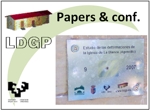Evaluation of the conventional surveying equipment applied to deformation analysis of heritage buildings. A case study: the bell tower of Santa María la Blanca church in Agoncillo (La Rioja, Spain)
VALLE MELÓN, José Manuel. RODRÍGUEZ MIRANDA, Álvaro. PÉREZ VIDIELLA, Pablo. Evaluation of the conventional surveying equipment applied to deformation analysis of heritage buildings. A case study: the bell tower of Santa María la Blanca church in Agoncillo (La Rioja, Spain). In: "Measuring the Changes", 13th FIG International Symposium on Deformation Measurements and Análisis, 4th IAG Symposium on Geodesy for Geotechnical and Structural Enginering (Lisbon, Portugal, Nov 12-15, 2008)
Abstract
[EN] A typical feature of heritage buildings is their fragility that is displayed by means of several pathologies such as wall sloping or cracks. Although there are some model projects on monitoring, they are usually enclosed in big restoration works, the budgets of which are ample enough to accommodate the cost. Except for these
cases, most of the churches, palaces or castles which makes up our vast heritage,
have to share the limited funds assigned to their maintenance where the geodetic analysis are just a luxury it cannot afford. In this paper, a case study carried out at Santa María la Blanca church (Agoncillo,
Spain), which shows significant deformations, is reported. For two years, a number of field campaigns are being observed exclusively with conventional surveying
equipment and benchmarks. Of course, we do not intend to perform a thorough monitoring but to answer the
questions whether the building is stable and the scale of the possible movements. In
order to accomplish this aim, the three-dimensional movements will be studied from
their horizontal representation and we will only use angular observations that are the most easily controllable. The main goal is to define a low-cost method useful as a tool for preliminary diagnosis and to permit optimising the cases in which we resort to detailed geodetic studies or consolidation works. [ES] Una de las características de los edificios patrimoniales es su fragilidad que
aparece representada por diversas patologías como inclinaciones o grietas. Aunque existen numerosos proyectos de control, normalmente se circunscriben a grandes trabajos de restauración cuyos presupuestos pueden acomodar ampliamente los costes. Excepto en estos casos, la mayoría de las iglesias,
palacios o castillos que componen nuestro vasto patrimonio, deben repartirse los
limitados recursos asignados a su mantenimiento donde los análisis geodésicos
son un lujo difícilmente asumible. En este artículo, se analiza el caso de la iglesia de Santa María la Blanca (Agoncillo, España), que muestra deformaciones significativas. Durante dos años se están realizando una serie de campañas de observación utilizando exclusivamente equipación y señales topográficas. Evidentemente, no se pretende realizar una auscultación completa sino responder a la pregunta de si el edificio es estable y la escala de los posibles movimientos. Con el fin de cumplir estos objetivos, los movimientos tridimensionales se estudiarán a partir de su componente horizontal y se utilizarán exclusivamente observables angulares ya que son los más fácilmente controlables. El objetivo principal es definir una metodología de bajo coste que sea una
herramienta útil para diagnósticos preliminares y que permita optimizar los casos en los que se recurre a estudios geodésicos de detalle o trabajos de consolidación.
Collections
Except where otherwise noted, this item's license is described as [EN] Permission is granted to quote short excerpts from this text, provided that the source of such material is fully acknowledged.
[ES] Está permitido citar y extractar brevemente el texto, siempre que la fuente sea claramente identificada.
 Back
Back

![[EN] Permission is granted to quote short excerpts from this text, provided that the source of such material is fully acknowledged.
[ES] Está permitido citar y extractar brevemente el texto, siempre que la fuente sea claramente identificada.](/themes/Mirage2//images/creativecommons/cc-by-nc-sa.png)